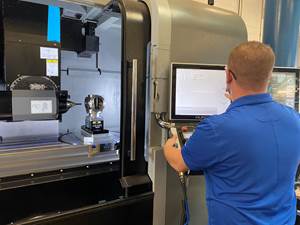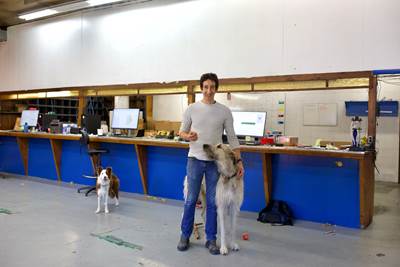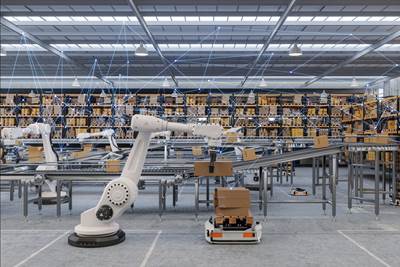How to Automate a Prototyping Shop
By focusing machine tending on pallets rather than individual parts, KAD Models has automated its high-mix, low-volume workload — and thrived as a result.
Share





The KAD Models team has nicknamed its FANUC M-710iC robot “Ripley.” It (and the rest of the AX5) are paired with a Haas UMC750 five-axis machine. The facility also has three other five-axis mills, one lathe, and seven 3+1-axis mills. Images courtesy of FANUC America.
Prototyping shops and automation are a seemingly counterintuitive pairing. If automation is to produce parts during lights-out periods or other times without direct operator supervision, spending time programming the automation would seem to make more sense for high-volume production parts than the low-volume, high-mix workload of prototyping shops. But as KAD Models’ Randolph, Vermont, location demonstrates, automation can work for prototyping shops — it just requires a shift in perspective on how to perform automation.
New Location, New Rules
Brian Kippen founded KAD Models in 2011 in the San Francisco Bay area, and still maintains a shop in Alameda, California. From this prototyping shop, Kippen and his team work with medical, consumer electronics, aerospace and automotive customers on low-volume production using a combination of Haas and Matsuura machines.
The shop’s first step toward automation came in 2018, when Kippen attended a distributor open house and saw a Trinity Automation system tending a Matsuura five-axis mill. Kippen wanted one as soon as possible — but the Alameda shop had no room for it.
One year later, however, Kippen moved to his home state of Vermont and bought a second location with greater square footage. He reached out to Trinity and bought one of its AX5 systems with a Haas UMC 750 attached, developing a plan for how to make it work with a prototyping workload. Kippen and Trinity got this system up and running by the end of January 2020. Two successful years later, Kippen invested in a second automation system for the Vermont location, this time a Trinity AX4 paired with a Matsuura five-axis mill.

As a prototyping shop, KAD Models deals with a wide range of difficult materials on a regular basis. “On any given week, we’ve gone through almost every common material,” Kippen says, and 17-4 stainless steel, 6061 stainless steel, Acetal and Delrin frequently appear.
Automation for Prototyping
At the heart of each AX system is a FANUC robot. The AX5 uses a FANUC M-710iC/50 robot with a 50-kg payload and 2,050-mm reach, while the AX4 uses a FANUC R-1000iA/100F robot with a 100-kg payload and a 2,230-mm reach. The AX5 is set up to focus on a single machine and while the AX4 has the ability to service two machines simultaneously, the version KAD has installed focuses on a single machine instead.
Rather than assign the robots to work with individual pieces, KAD assigns them to work with pallets loaded with fixtured parts, bypassing a lot of the troubles with automating high-mix workloads. Kippen says that the system is less a tending robot than a “cafeteria worker” loading up trays. As long as the pallet can hold the part, the system works.
Kippen describes the process of working with Trinity as creating a system that enables his shop to use automation, rather than simply creating an automation system. Trinity trains the systems on where to pick up pallets during installation, and training employees on the system is a matter of minutes rather than days.
Operators assign programs to pallets through a touchscreen HMI located at the AX operator station, which is linked to each machine’s control. Individual programs in the system appear in a drop-down menu, pulling directly from the machines to ensure there is no disconnect between the two (and that there are no resulting errors during lights-out operation). This system can run as many unique part numbers as there are programs in the control with corresponding tools on the machines, and is compatible with lot sizes down to a single part.
KAD Models does not need to program the robots for its AX systems at any time. All the robotic programming is handled by Trinity before the robots arrive, and everything from that point is just part programming on the machine itself. Because the facility only runs a single shift, and automation works perfectly at night, this leads to daytime programming and proving out of programs, with nights dedicated to producing these proven parts.
In the event of a broken tool during the night, the shop has programmed in an M99 fail-safe that loops the CNC back to the automation program. This enables the shop to continue carrying out machining on its other pallets while not causing any damage to the parts that require a new tool.
Nick Tonti, national sales manager for Trinity, says loading parts into fixtures on the pallets maintains a connection between the shopfloor staff and the automated work. The automation handles the “low-hanging fruit” of machine tending, while human operators ensure that parts are correctly loaded into the fixtures. This eliminates the risk of chips interfering with workholding or parts not seating correctly into the workholding devices, which Tonti says are common issues with automated machine tending. Kippen paints a vivid picture of the dangers of chips getting into the vice, saying that when chips get into the vice “it turns into a trash compactor . . . the clamping force just happens on chips and not on parts.”

Because of the importance of programming in ensuring smooth nighttime production, KAD Models cross-trains its operators to also be skilled programmers.
Solving Problems, Wherever They Are
Kippen says KAD Models has a culture focused on problem-solving, something that helps with both prototyping work and figuring out the place of automation in a nontraditional environment.
This is also a useful trait for figuring out how to train a new generation of talent. Kippen notes that it is difficult to bring in new employees who are both technically minded and skilled, especially in rural Vermont. He can hire for the former and train for the latter, but this training takes time, and time is always at a premium in a job shop. The Trinity systems’ ability to work with multiple part programs in a single overnight shift also requires that all employees be skilled at both traditional machinist tasks and CAM programming for maximum productivity. But rather than being an extra burden, this is where the Trinity systems come in handy. So long as the systems run successfully during the night, the shop can afford to train staff to program jobs and do more intensive setups — and parts that don’t fit on the pallets — during the day.
The first Trinity Automation cell played a large role in enabling the Vermont facility to reach the same revenue as the California facility in less than 18 months. Even in the last two years, when Kippen has taken a less hands-on role as he teaches manufacturing classes at a nearby high school, the combination of Trinity cells has helped the shop stay above 10% year-over-year growth.
Currently, Kippen says KAD Models quotes parts in less than an hour and usually gets parts out in under a week. He says that this is about as far as the shop can go with its current capacity limits, and that there are already weeks in which the Vermont facility runs the automation systems over the weekend and all night long to maximize spindle uptime. KAD plans to soon expand to a third facility, however, this one also in Vermont. Kippen plans to automate this facility as well, with Trinity at the top of his list for both its robotic cells and its service.
Related Content
Which Approach to Automation Fits Your CNC Machine Tool?
Choosing the right automation to pair with a CNC machine tool cell means weighing various factors, as this fabrication business has learned well.
Read MoreBuilding Machines and Apprenticeships In-House: 5-Axis Live
Universal machines were the main draw of Grob’s 5-Axis Live — though the company’s apprenticeship and support proved equally impressive.
Read MoreHigh RPM Spindles: 5 Advantages for 5-axis CNC Machines
Explore five crucial ways equipping 5-axis CNC machines with Air Turbine Spindles® can achieve the speeds necessary to overcome manufacturing challenges.
Read MoreDoes a Five-Axis Machine Increase Business?
Five-axis machining is enabling custom fabricator Meyer Tool to take on more complex work and helping it produce less complex jobs more efficiently.
Read MoreRead Next
Premier Prototyping Machine Shop Thrives on Software
Front-office automation and a discerning approach to work-free time for skilled CAM programmers to do what they do best.
Read MoreHow to Choose the Right Automation Solution for Your Shop
Consider what types of implementation your shop prefers when deciding between workpiece-handling and pallet-handling automation solutions.
Read MorePartial Automation Inspires Full Cobot Overhaul
Targeting two-to-four hours of nightly automation enables high-mix manufacturer Wagner Machine to radically boost its productivity past a single shift.
Read More





















.jpg;maxWidth=300;quality=90)









